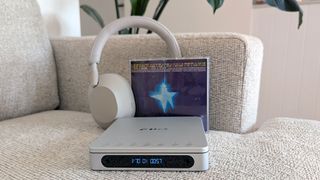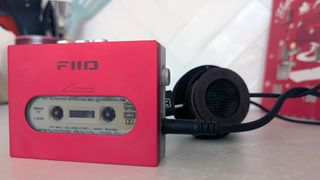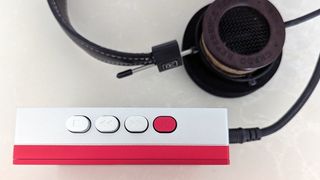Jack White doesn’t love his music being described as ‘retro’. “Anything that starts with ‘re’ – like retro, reinvent, recreate… it’s always like living in the past – copying, emulating,” he once said. But like many of us, he seems to love retro music playback. After all, he co-founded the vinyl-focused label Third Man Records and under it has released several of his albums on not only vinyl but also cassette. As have the likes of Taylor Swift and Phoebe Bridgers with their music, and Disney with today’s best-selling tapes, the Guardians Of The Galaxy: Awesome Mix volumes. White and his fellow tape-backing artists might perhaps then be fans of FiiO’s ‘Retro Product’ category. The Chinese manufacturer has incited nostalgia big time this year by launching two products in particular within it – and ‘retro’ is exactly the descriptor it’s going for.
There are currently three devices under that category umbrella. One is the TT13 fully automatic turntable, which in my mind is no less contemporary a product type today than an electric car, but the other two do, however, firmly fit the retro bill; they are a portable CD player (DM13) and portable cassette player (CM13). No arguments there, right? Unlike vinyl, they are, as technological concepts in the here and now, closer to dead than alive.
I don’t expect either legacy devices or formats to take off in the same way the turntable and record have done over the past decade, despite the recent rise in CD’s popularity and the efforts of some artists and film studios to release cassette tapes – but that doesn’t mean they shouldn’t exist as niche offerings. The world now has cadence-measuring socks, for crying out loud. In fact, having spent a week rewinding my modernised brain and, more literally, what remains of my physical music collection, to play with them both, I’m rather glad they turned up.
FiiO DM13 portable CD player
Let me make this clear from the outset: both products will likely find niche audiences. 2025 isn’t going to be the year Discmans start lining shop shelves where iPods used to be, or when we see people using pencils to fix tapes on trains. The plausible scenario I imagine for the DM13 takes place on a sofa. Headphones – probably of the wired variety – are connected to it, and on the other side of that cable are the ears of someone who predominantly plays music on their laptop or on a home system, probably via a streaming service, but who still cherishes a CD collection that they want to play occasionally via a flexible and affordable source.
Yes, that’s a far cry from the product’s initial milieu in the late ’80s and ’90s, where they would go everywhere with you – as your phone does today. Mine (referred to as the ‘CD Walkman’ in my day) was mostly used in the car when my parents increased the volume on Andrea Bocelli (I know… but I was a rap fan as a teenager) or started talking about their next home improvement project, and tucked into the back pocket of the driver’s seat. Sure, you could carry the DM13 around with you – it’s a free world and the effective ESP (electronic skip protection) mode allows you to haphazardly carry it sideways-on or upside-down without much playback interference at all. I tucked it into the back of my jeans (pocket-size? No chance) while hoovering and had no issues. But ultimately it’s about as practical and comfortable to carry around as a pinecone.
Anyway, while my Discman days are obviously some time ago now, I initially unboxed the DM13 with confidence and tossed aside the Quick Start manual as if it was one of Wine Club Vouchers you seemingly find inside every package these days. Using a Discman should surely be like riding a bike, especially for someone who considers themselves pretty damn tech-savvy. I was humbled, then, when I had powered the thing on, inserted my Kasabian Velociraptor! disc (found inside my case for The Cure’s Greatest Hits – why, of course, some things never change), plugged in my headphones and yet couldn’t get sound out or the relentless ‘pairing’ wording off the screen.

‘Pairing’? That’s not something I remembered from my Discman days in the backseat of the car. I coyly picked up the manual; the thing has Bluetooth! The integration of this mod-con naturally means the player can wirelessly send your spinning discs to Bluetooth headphones or a wireless speaker/other audio component in ‘standard’ SBC or the higher-quality aptX/aptX HD codec. And to change its output to the 3.5mm and 4.4mm headphone jacks on the player’s front, either side of the screen, you must press the power button a couple of times… of course.
There are some visual giveaways that this is the brainchild of a product team or engineer in the s and not the 1990s, too. Firstly, the blue-on-black LCD display is much more à la mode than the old players’ black-on-green/grey screens that used to match your bedside alarm clock, and thankfully it is bigger than the size of a thumbprint. It shows volume, track number and time, though sadly not scrolling song titles. If streaming has hampered the tactility of music playback it has also affected its visual experience as we press ‘play’ and click away to another screen, so it would’ve been nice for the DM13 to bring some of that back.
Secondly, on the rear panel are 4.4mm balanced and 3.5mm coax/optical outputs so that the player can be connected to powered speakers or used as a source in an audio system. Two USB-C ports – one for ripping CDs to your computer/laptop (handy) and another for charging the built-in battery (no compartment for AA batteries or clunky external chargers here) – complete the contemporary-as-they-come connectivity. Incidentally, the battery goes for 10 hours, lasting the week I dipped into it, but a Desktop Mode switch can be flicked on to bypass the battery and use power obtained over USB when connected.
So yes, the DM13 has been fitted out for the present. Naturally, its sonic architecture is up to date too, based around two flagship Cirrus Logic DAC chips and low-noise headphone amps (FiiO probably couldn’t have sourced the ol’ stuff if it tried) and making for a surprisingly decent-sounding spinner – significantly clearer, fuller, punchier and more musically adroit than either streamed albums sounded out of my Macbook (although the preference expectedly fell the other way once I added my most modest DAC, around £350, to the laptop chain). Do yourself a favour and pair the DM13 with at least a budget pair of wired headphones, though; you’ll make the most of its potential that way and save the extra few quid opting for the non-Bluetooth version of the DM13.
My only real reservation about this niche retro-inspired portable is how it looks, which is functional over fun – modern, minimalist, sleek and… square? Forget the fugly former players of the ’80s and ’90s, like the Sony D-Z555 and Technics SL-XP5, Discmans today should be round! Like they were in the noughties. While the player can be bought in a funky red finish, I still think FiiO should’ve had more fun with retro visual cues here. Then again, perhaps all the team’s creativity had gone into making the CP13 cassette player…
FiiO CP13 portable cassette player

Surprisingly rock-solid and rectangular casing (the shape is right this time), big and chunky playback push-buttons and a transparent window to watch those hypnotic cogs wind – now we’re talking. I reckon the Early Learning Centre design vibes are spot on for FiiO’s cassette deck, which wouldn’t look out of place as a prop in a Lego movie.
Music-listening hardware has ‘evolved’ over the decades to be more convenient and less tactile, so it makes sense that the CP13 is more physical than the DM13. It gives you feedback; the buttons are satisfyingly noisy, the cogs turn before your eyes, and, if you put your ear to the machine, you can hear the cogs’ mechanical whirr. The addition of the more sophisticated volume dial on the side panel offers another means of interaction. That said, the small indent on the door that allows you to prize it open and insert a tape is the hands-on (or rather fingernail-in) design trait I would’ve swapped for a brash and bold slider-switch (as on the DM13) any day. Us poor nail-biters.
There’s a USB-C power port (battery life is 13 hours claimed; I got a little less) and a 3.5mm audio jack, and that’s it. “We also chose to make the movement as simple as possible, removing the recording and auto-reverse functions, in order to focus on bringing max playback sound quality,” says FiiO. Indeed, despite the defiantly retro and perhaps relatively ‘crude’ aesthetic, under the hood is some serious business.
FiiO says that, regardless of the cost repercussions, it negotiated with its supplier to only use the highest-quality cassette heads (“less than 40 per cent of what is produced”) and that the head has a thicker-than-usual cover for better shielding. It also chose a larger copper flywheel that supposedly helps the tape reel move smoothly and keep wow and flutter low, as well as a higher-voltage power supply than is typical, which works alongside a motor speed stabilisation circuit to ensure stable speed and reduce rogue pitch changes.
No wonder I was slightly taken aback as the deep keyboard chords opening Tina Turner’s Simply The Best punched out through my Grado headphones. OK, so the presentation is a bit bereft of deep bass and may be a little forward for some tastes. If this is your first cassette rodeo, you may be surprised by the lack of refinement and polished cleanliness of digital music delivery these days. But it’s enjoyably sparkly up top, pretty detailed and spacious all-round, and overall nicely clear and coherent. Powerful enough to drive my mid-range Sennheiser earbuds and high-end Grado over-ears, too. Listening to a tape from start to finish is refreshing, while the challenge to forward-wind to just the moment a track begins is shamefully addictive.

So who is the CP13 for? Well, if the DM13 is akin to the niche cadence-measuring socks of the smart clothing world, the CP13 is more like its even nicher phone-controlling jacket. It would, however, well serve the small audience of cassette owners and listeners whose old player went bust or who have never owned one. I imagine they would be attracted to the evocative design, attractive price (£95 / $80 / AU$180 at Amazon) and decent enough performance in a market where options are very few. If I still had my original cassette collection (as opposed to just three tapes!) or the desire to get onboard with the newly released and limited-edition tapes being dropped nowadays, it would have been on my wishlist for Santa for sure.
As for the DM13, I’m not so sure, given I do own and occasionally play CDs but already have a disc player in my home system. Make it round and perhaps I’d consider it…
MORE:
CES 2025 preview: what to expect from the world’s biggest tech show
14 exciting hi-fi and home cinema products we can’t wait to review in 2025
We’ve built a versatile vinyl and streaming system that brings the best of both worlds – but doesn’t cost the earth






